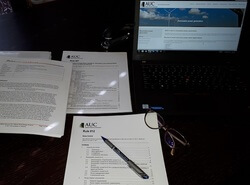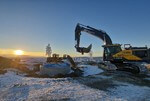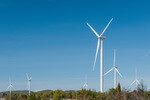News Release from Canadian Renewable Energy Association (CanREA)
Wind Industry Profile of
A primer on Alberta’s wind energy permitting and environmental requirements
The announcement of successful wind energy projects in Alberta’s recent renewable electricity procurement has spurred interest in the permitting, environmental and other regulatory requirements that apply to renewable energy projects. Many think renewable power projects are given the ‘green-light’ without consideration for potential environmental impacts beyond greenhouse gas emissions. In actuality, wind energy projects require multiple permits and approvals from all three levels of government, as well as environmental assessment, throughout the project lifecycle (planning, construction, operation and decommissioning/repowering).
The agencies and regulatory bodies included in the permitting process include:
- The Alberta Utilities Commission
- Alberta Environment and Parks
- Alberta Culture and Tourism
- Transport Canada
- NavCanada
- Environment Canada
- Alberta Transportation
- Local municipalities
Further information on the specific requirements of each agency or regulatory body is explained below.
In Alberta, provincial environmental approvals are issued by the Alberta Utilities Commission (AUC), which approves new power facilities and changes to existing facilities through Rule 007: Applications for Power Plants, Substations, Transmission Lines, Industrial System Designations and Hydro Developments. Rule 007 applies the same standards to the potential environmental impacts of wind energy facilities as to coal-fired or natural gas-fired power plants, or any other power plant. In addition, when wind facilities require modifications or come to their end of life, an additional AUC application and consultation process is required.
Rule 007 also requires that Alberta Environment and Parks reviews the project and provides a Renewable Energy Referral Report to the AUC to consider for project approval. A document clarifying the roles and responsibilities of the AUC and Environment and Parks in the approval process for renewable power plants was published in March 2018.
Alberta Environment and Parks’ 30-page Wildlife Directive for Alberta Wind Energy Projects provides guidelines to minimize impacts to wildlife and wildlife habitat during the siting, construction, operation and decommissioning of wind farms in Alberta and identifies ecologically-sensitive areas which should be avoided, such as wildlife habitat and wetlands. The directive contains 46 standards and 19 best management practices and summarizes potential wildlife issues associated with wind energy developments. The directive also contains requirements for a minimum of one-year of pre-construction surveys to better understand the wildlife populations near to the project, and three-years of post-construction monitoring to assess if wind facilities are effectively mitigating potential wildlife impacts. If not, operational changes will be mandated by Environment and Parks, and post-construction surveys will continue to measure their effectiveness.
All pre-construction surveys must be completed by an experienced wildlife biologist and must be “considered current.” In other words, the last survey must be completed within two years to the date when the project begins operating. Post-construction monitoring surveys must be completed weekly, from March to October, at each turbine site selected for monitoring after projects become operational.
Beyond environmental aspects of the project, the AUC also assesses property impacts and safety and decommissioning plans during their review process, if required. Rule 007 also has extensive stakeholder consultation requirements, which are assessed for adequacy and scope during the review process as well.
Wind projects must complete a noise impact assessment in accordance with another AUC rule, Rule 012: Noise Control. The purpose of this rule is to ensure that the sound from the wind farm, when combined with sounds from other energy-related facilities, such as pump jacks, pipelines or other power generation in the area, does not exceed an allowed sound level. For example, the permissible sound level at night for a dwelling that has a density of one to eight dwellings per quarter section and is located at a distance of more than or equal to 500 metres from heavily travelled roads or rail lines, and is not subject to frequent aircraft flyovers is 40 decibels For reference, 40 decibels is similar to the sound level at a library or on a quiet residential street. For daytime (between 7 a.m. and 10 p.m.), an adjustment of 10 decibels above the nighttime basic sound level is allowed.
The AUC’s approval is contingent on the completion of a number of federal-level processes:
- completion of the Aeronautical Assessment Form for Obstruction Marking and Lighting to Transport Canada to ensure the wind project can been seen and does not present a hazard to aviation safety;
- an evaluation from NavCanada to determine if the wind facility will impact airport radar, navigation aids and communications systems; and
- an Environment Canada assessment of impacts on weather radar.
In addition to the AUC and Alberta Environment and Parks oversite, assessment and/or approvals are also required from Alberta Transportation (e.g. for a wind power plant that is within 300 metres of a numbered highway), and Alberta Culture and Tourism (e.g. to determine if historical, archaeological or paleontological sites are close to the power plant site).
At the local level, municipalities and utilities, as well as telecommunications and pipelines companies, may also have requirements for integrating infrastructure.
The wind developer must also work with the Alberta Electric System Operator to connect the facility to the electricity grid, and all related transmission infrastructure must go through its own permitting and consultation process with the AUC.
As you can see, wind energy permitting is a rigorous process that involves many players. It ensures that wind energy projects are sited appropriately, and are good neighbours.
Resources
Environmental Aspects of Wind and Solar Projects in Alberta
New Alberta wind energy guidelines include prescriptive environmental requirements
- Source:
- CanWEA
- Author:
- Ameera Shivji
- Link:
- canwea.ca/...
- Keywords:
- Canada, CanWEA; Alberta, permitting, apprival, wind farm, government




























